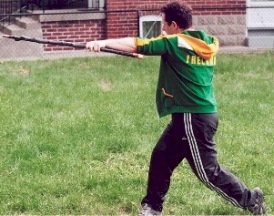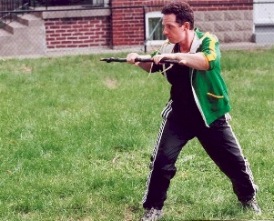|
The Stick Punch
There are two types of stick punches in Rince an Bhata Uisce Bheatha: long-range and short-range. The long-range stick punch is a one-handed grip punch with up to full extension of the arm and bata. The short-range stick punch is a two-handed grip punch which therefore limits the stick's range.
Both can be used offensively as well as defensively to block an opponent's strike.
|
|
The Stick Punch: Long-Range
Similar to a boxer's punch or jab, the long-range stick punch is executed in one swift, continuous, powerful motion. As shown in the photo sequence below, it can be executed with either hand. The non-punching hand releases its grip on the stick while the punching hand snaps the stick outwards and immediately returns it to the starting position all within a split second.
When looking at the photos below, keep in mind that Glen is a southpaw so his strongest stick punch is from his left hand. Therefore, those familiar with the one-handed grip Irish stick fighting style would expect that Glen would hold the bata in the opposite way so that the knobbed end would strike his opponent when he stick punches with his left hand. However, in the Uisce style the knob end is more important for disarming and other techniques rather than for striking an opponent. This will be explained more in the pages that follow.
Click on any of the photos below to see an enlarged version.
|

|
1. Starting position. Both hands are spaced evenly on the bata so that a stick punch can be executed by either hand at any time.
|
|

|
2. Glen simultaneously snaps his bata outward with his wrist while thrusting his arm outward. It's an entire body move that gives the stick punch a lot of power. The bata actually hits the back of Glen's forearm. This both aids in the control of the bata and facilitates the return of the bata to the starting position.
|
|

|
3. Glen quickly returns the bata and his body back to the starting position. The entire move is as fast as a boxer's punch.
|
|

|
4. Back to the starting stance and ready to now execute a stick punch with his right hand.
|
|

|
5. Again he snaps the bata outward but because Glen is a southpaw there is less power with his right-handed stick punch.
|
|

|
6. Back to the starting position
|
|
|
It takes a little getting used to, but beginners eventually get conditioned to their own bata striking their forearms during the stick punch.
Note that the long-range stick punch is one of the few moves in the Rince an Bhata Uisce Bheatha style where BOTH hands are not on the stick.
Although the obvious purpose of a stick punch is to strike the opponent and to block an opponent's strike, it's main purpose is to initiate a charge-in. The Uisce Beatha style has the advantage at short-range distances so practitioners of this style want to move in on their opponent as soon as possible.
The Trinity is a training exercise that involves continuous, consecutive, rapid-fire stick punches aimed sequentially at three key locations of an imaginary opponent -- namely the head, the left hand, and the right hand. These three points form a small triangle and therefore this exercise improves both aim and bata control. The Trinity is first performed with one hand for several repetitions and then repeated with the other hand.
|
|
The Stick Punch: Short-Range
For a short-range stick punch, both hands maintain their grip on the bata throughout the entire movement. The ends of the bata are treated as if they were extensions of the fist. Unfortunately we don't have a photo of a simple short-range stick punch. To picture the move, just imagine what a boxer would look like if he had to maintain a grip on a stick with both hands while executing a punch. The main difference is that instead of making contact with the fist itself, contact is made with the portion of the bata that extends from the hand.
Also in the short-range stick punch category are all of the ways that a stick can be powered with the basic two-handed grip such that it makes contact with the opponent. This includes jabbing the opponent with the tip of either end of the bata.
Short-range stick punches are used after the fighter has moved in on his opponent in many of the same ways that a boxer uses punches once he has moved in on his opponent.
|
|
|
|